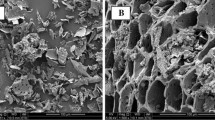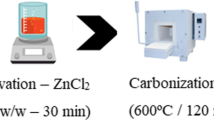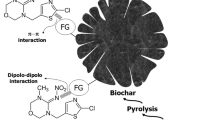Abstract
The study investigated the adsorption of sulfamethoxazole, a pharmaceutical water contaminant, on an adsorbent derived from reed canary grass. Adsorption isotherm data at different temperatures were analyzed by the Langmuir, Freundlich, Sips, Dubinin-Radushkevich, Fowler–Guggenheim, and Nitta isotherm models. Among the various isotherm models, Sips model simulated the experimental adsorption data slightly better with the least error, indicating a heterogeneous monolayer adsorption system with a maximum adsorption capacity of 147.9 mg/g and heterogeneity index of 1.15. Investigation of the Fowler–Guggenheim and Nitta models showed that interaction energy of adsorbed molecules was insignificant. Thermodynamic parameters were determined using Henry constants. Henery constants were 22.7, 17.5, and 10.8 L/g at 15℃, 25℃, and 35℃. The change in enthalpy of adsorption was -27.5 kJ/mol, showing that the process is exothermic and physiosorption. The change in standard entropy was -23.2 J/(mol·K), suggesting a decrease in randomness during the adsorption process. Weighted mean of site energy distribution remained constant at 11.2 when adsorption temperature was increased from 15℃ to 25 ℃, and the weighted mean slightly decreased to 9.6 at 35 ℃, indicating weaker interactions at the higher temperature. The methodology used in this work to analyze interaction energy between adsorbed molecules can be transferrable to analyze data of adsorption of other pharmaceuticals or organics by various types of adsorbents.








Similar content being viewed by others
Data availability
Data are available upon request.
References
Mourabet M, El Boujaady H, El Rhilassi A, Ramdane H, Bennani-Ziatni M, El Hamri R, Taitai A (2011) Defluoridation of water using brushite: equilibrium, kinetic and thermodynamic studies. Desalination 278:1–9
Foo KY, Hameed BH (2010) Insights into the modeling of adsorption isotherm systems. Chem Eng J 156:2–10. https://doi.org/10.1016/j.cej.2009.09.013
Duong DD (1998) Adsorption analysis: equilibria and kinetics. Imperial College Press, London
Aghababaei A, Azargohar R, Dalai AK, Soltan J, Niu CH (2022) Adsorption of carbamazepine from water by hydrothermally and steam activated agricultural by-products: equilibrium, site energy, and thermodynamic studies. Chem Eng Commun 209:852–867
Bui TX, Choi H (2009) Adsorptive removal of selected pharmaceuticals by mesoporous silica SBA-15. J Hazard Mater 168:602–608
Ahmed MJ, Hameed BH (2019) Adsorptive removal of selected pharmaceuticals by mesoporous silica SBA-15. J Environ Manag 252:109617
Fallou H, Cimetiere N, Giraudet S, Wolbert D, Le Cloirec P (2016) Adsorption of pharmaceuticals onto activated carbon fiber cloths–modeling and extrapolation of adsorption isotherms at very low concentrations. J Environ Manag 166:544–555
Rizzo L, Malato S, Antakyali D, Beretsou VG, Đolić MB, Gernjak W, Heath E, Ivancev-Tumbas I, Karaolia P, Ribeiro A, Mascolo G, McArdell CS, Schaar H, Silva AMT, Fatta-Kassinos D (2019) Consolidated vs new advanced treatment methods for the removal of contaminants of emerging concern from urban wastewater. Sci Total Environ 655:986–1008. https://doi.org/10.1016/j.scitotenv.2018.11.265
Chaturvedi P, Shukla P, Giri BS, Chowdhary P, Chandra R, Gupta P, Pandey A (2021) Prevalence and hazardous impact of pharmaceutical and personal care products and antibiotics in environment: a review on emerging contaminants. Environ Res 194:110664. https://doi.org/10.1016/j.envres.2020.110664
Yao Y, Gao B, Chen H, Jiang L, Inyang M, Zimmerman AR, Cao X, Yang L, Xue Y, Li H (2012) Adsorption of sulfamethoxazole on biochar and its impact on reclaimed water irrigation. J Hazard Mater 209:408–413
Gothwal R, Shashidhar T (2015) Antibiotic pollution in the environment: a review. Clean - Soil Air Water 43:479–489. https://doi.org/10.1002/clen.201300989
Felis E, Kalka J, Sochacki A, Kowalska K, Bajkacz S, Harnisz M, Korzeniewska E (2020) Antimicrobial pharmaceuticals in the aquatic environment-occurrence and environmental implications. Eur J Pharmacol 866:172813
Wang S, Wang H, Liu Y, Fu Y (2020) Effective degradation of sulfamethoxazole with Fe2+-zeolite/peracetic acid. Sep Purif Technol 233:115973
Brown KD, Kulis J, Thomson B, Chapman TH, Mawhinney DB (2006) Occurrence of antibiotics in hospital, residential, and dairy effluent, municipal wastewater, and the Rio Grande in New Mexico. Sci Total Environ 366:772–783. https://doi.org/10.1016/j.scitotenv.2005.10.007
Akhtar J, Amin NAS, Shahzad K (2016) A review on removal of pharmaceuticals from water by adsorption. Desalin Water Treat 57:12842–12860
Tambosi JL, Yamanaka LY, José HJ, De Fátima Peralta Muniz Moreira R, Schröder HF (2010) Recent research data on the removal of pharmaceuticals from sewage treatment plants (STP). Quim Nova 33:411–20. https://doi.org/10.1590/S0100-40422010000200032
Al Sharabati M, Abokwiek R, Al-Othman A, Tawalbeh M, Karaman C, Orooji Y, Karimi F (2021) Biodegradable polymers and their nano-composites for the removal of endocrine-disrupting chemicals (EDCs) from wastewater: a review. Environ Res 202:111694
Hung YT, Lo HH, Wang LK, Taricska JR, Li KH (2005) Granular activated carbon adsorption. In Physicochemical treatment processes. Humana Press, Totowa, NJ, pp 573–633
González-García P (2018) Activated carbon from lignocellulosics precursors: a review of the synthesis methods, characterization techniques and applications. Renew Sustain Energy Rev 82:1393–1414. https://doi.org/10.1016/j.rser.2017.04.117
Zamiri MA, Niu CH (2022) Industrial crops & products development and characterization of novel activated carbons based on reed canary grass. Ind Crop Prod 187:115316. https://doi.org/10.1016/j.indcrop.2022.115316
Yan B, Niu CH (2017) Modeling and site energy distribution analysis of levofloxacin sorption by biosorbents. Chem Eng J 307:631–642. https://doi.org/10.1016/j.cej.2016.08.065
Davis JA, Leckie JO (1980) Surface ionization and complexation at the oxide/water interface. 3. Adsorption of anions. J Colloid Interface Sci 74:32–43
Movasaghi Z, Yan B, Niu C (2019) Adsorption of ciprofloxacin from water by pretreated oat hulls: equilibrium, kinetic, and thermodynamic studies. Ind Crops Prod 127:237–250. https://doi.org/10.1016/j.indcrop.2018.10.051
Thevannan A, Mungroo R, Niu CH (2010) Biosorption of nickel with barley straw. Bioresour Technol 101:1776–1780
Aghababaei A, Azargohar R, Dalai AK, Soltan J, Niu CH (2021) Effective adsorption of carbamazepine from water by adsorbents developed from flax shives and oat hulls: key factors and characterization. Ind Crops Prod 170:113721
Wang J, Guo X (2020) Adsorption kinetic models: physical meanings, applications, and solving methods. J Hazard Mater 390:122156
Langmuir I (1918) The adsorption of gases on plane surfaces of glass, mica and platinum. J Am Chem Soc 40:1361–1403. https://doi.org/10.1021/ja02242a004
Tonucci MC, Gurgel LVA, de Aquino SF (2015) Activated carbons from agricultural byproducts (pine tree and coconut shell), coal, and carbon nanotubes as adsorbents for removal of sulfamethoxazole from spiked aqueous solutions: kinetic and thermodynamic studies. Ind Crops Prod 74:111–121
Yang Y, Wu Y, Liu H, Ribeiro AM, Li P, Yu J, Rodrigues AE (2016) Enrichment of ventilation air methane by adsorption with displacement chromatography technology: experiment and numerical simulation. Chem Eng Sci 149:215–228
Wang J, Guo X (2020) Adsorption isotherm models: classification, physical meaning, application and solving method. Chemosphere 258:127279
Nitta T, Shigetomi T, Kuro-Oka M, Katayama T (1984) An adsorption isotherm of multi-site occupancy model for homogeneous surface. J Chem Eng Jpn 17:39–45
Barbero G, Evangelista LR, Lelidis I (2021) Effective adsorption energy and generalization of the Frumkin-Fowler-Guggenheim isotherm. J Mol Liq 327:114795
Boulanger E, Huang L, Rupakheti C, MacKerell AD Jr, Roux B (2018) Optimized Lennard-Jones parameters for druglike small molecules. J Chem Theory Comput 14:3121–3131
Farouq R, Yousef NS (2015) Equilibrium and kinetics studies of adsorption of copper (II) ions on natural biosorbent. Int J Chem Eng Appl 6:319
Hamdaoui O, Naffrechoux E (2007) Modeling of adsorption isotherms of phenol and chlorophenols onto granular activated carbon. Part I. Two-parameter models and equations allowing determination of thermodynamic parameters. J Hazard Mater 147:381–94. https://doi.org/10.1016/j.jhazmat.2007.01.021
Rossner A, Snyder SA, Knappe DRU (2009) Removal of emerging contaminants of concern by alternative adsorbents. Water Res 43:3787–3796
Çalışkan E, Göktürk S (2010) Adsorption characteristics of sulfamethoxazole and metronidazole on activated carbon. Sep Sci Technol 45:244–255
Calisto V, Ferreira CIA, Oliveira JABP, Otero M, Esteves VI (2015) Adsorptive removal of pharmaceuticals from water by commercial and waste-based carbons. J Environ Manag 152:83–90. https://doi.org/10.1016/j.jenvman.2015.01.019
Choi YK, Kan E (2019) Effects of pyrolysis temperature on the physicochemical properties of alfalfa-derived biochar for the adsorption of bisphenol A and sulfamethoxazole in water. Chemosphere 218:741–748. https://doi.org/10.1016/j.chemosphere.2018.11.151
Sun B, Lian F, Bao Q, Liu Z, Song Z, Zhu L (2016) Impact of low molecular weight organic acids (LMWOAs) on biochar micropores and sorption properties for sulfamethoxazole. Environ Pollut 214:142–148. https://doi.org/10.1016/j.envpol.2016.04.017
Ahmed MB, Zhou JL, Ngo HH, Guo W, Johir MAH, Sornalingam K (2017) Single and competitive sorption properties and mechanism of functionalized biochar for removing sulfonamide antibiotics from water. Chem Eng J 311:348–358. https://doi.org/10.1016/j.cej.2016.11.106
Reguyal F, Sarmah AK, Gao W (2017) Synthesis of magnetic biochar from pine sawdust via oxidative hydrolysis of FeCl2 for the removal sulfamethoxazole from aqueous solution. J Hazard Mater 321:868–878
Zbair M, AitAhsaine H, Anfar Z (2018) Porous carbon by microwave assisted pyrolysis: an effective and low-cost adsorbent for sulfamethoxazole adsorption and optimization using response surface methodology. J Clean Prod 202:571–581. https://doi.org/10.1016/j.jclepro.2018.08.155
Wang F, Sun W, Pan W, Xu N (2015) Adsorption of sulfamethoxazole and 17β-estradiol by carbon nanotubes/CoFe2O4 composites. Chem Eng J 274:17–29
Teixeira S, Delerue-Matos C, Santos L (2012) Removal of sulfamethoxazole from solution by raw and chemically treated walnut shells. Environ Sci Pollut Res 19:3096–3106. https://doi.org/10.1007/s11356-012-0853-9
Pamphile N, Xuejiao L, Guangwei Y, Yin W (2019) Synthesis of a novel core-shell-structure activated carbon material and its application in sulfamethoxazole adsorption. J Hazard Mater 368:602–612
Liu Y, Liu X, Zhang G, Ma T, Du T, Yang Y, Lu S (2019) Adsorptive removal of sulfamethazine and sulfamethoxazole from aqueous solution by hexadecyl trimethyl ammonium bromide modified activated carbon. Colloids Surfaces A Physicochem Eng Asp 564:131–141
Jaria G, Calisto V, Gil MV, Ferreira P, Santos SM, Otero M, Esteves VI (2021) Effects of thiol functionalization of a waste-derived activated carbon on the adsorption of sulfamethoxazole from water: kinetic, equilibrium and thermodynamic studies. J Mol Liq 323:115003
Calisto V, Jaria G, Silva CP, Ferreira CIA, Otero M, Esteves VI (2017) Single and multi-component adsorption of psychiatric pharmaceuticals onto alternative and commercial carbons. J Environ Manag 192:15–24. https://doi.org/10.1016/j.jenvman.2017.01.029
Blanco SPDM, Scheufele FB, Módenes AN, Espinoza-Quiñones FR, Marin P, Kroumov AD, Borba CE (2017) Kinetic, equilibrium and thermodynamic phenomenological modeling of reactive dye adsorption onto polymeric adsorbent. Chem Eng J 307:466–475
Lima EC, Hosseini-Bandegharaei A, Moreno-Piraján JC, Anastopoulos I (2019) A critical review of the estimation of the thermodynamic parameters on adsorption equilibria. Wrong use of equilibrium constant in the Van’t Hoof equation for calculation of thermodynamic parameters of adsorption. J Mol Liq 273:425–34
Prola LDT, Machado FM, Bergmann CP, de Souza FE, Gally CR, Lima EC, Adebayo MA, Dias SLP, Calvete T (2013) Adsorption of direct blue 53 dye from aqueous solutions by multi-walled carbon nanotubes and activated carbon. J Environ Manag 130:166–175
Ben-Tal N, Honig B, Bagdassarian CK, Ben-Shaul A (2000) Association entropy in adsorption processes. Biophys J 79:1180–1187
Carter MC, Kilduff JE, Weber WJ (1995) Site energy distribution analysis of preloaded adsorbents. Environ Sci Technol 29:1773–1780
Zhou Y, He Y, He Y, Liu X, Xu B, Yu J, Dai C, Huang A, Pang Y, Luo L (2019) Analyses of tetracycline adsorption on alkali-acid modified magnetic biochar: site energy distribution consideration. Sci Total Environ 650:2260–2266
Cerofolini GF (1974) Localized adsorption on heterogeneous surfaces. Thin Solid Films 23:129–152
He J, Guo J, Zhou Q, Fang F (2019) Adsorption characteristics of nitrite on natural filter medium: kinetic, equilibrium, and site energy distribution studies. Ecotoxicol Environ Saf 169:435–441. https://doi.org/10.1016/j.ecoenv.2018.11.039
Hu J, Tong Z, Hu Z, Chen G, Chen T (2012) Adsorption of roxarsone from aqueous solution by multi-walled carbon nanotubes. J Colloid Interface Sci 377:355–361
Acknowledgements
The authors also would like to thank Dr. Jeff Schoenau, Professor of Department of Soil Science at the University of Saskatchewan for providing with raw reed canary grass. The authors would like to thank Mrs. Dushmanthi Jayasinghe, technician at the Department of Chemical and Biological Engineering of the University of Saskatchewan, for providing support to operate the HPLC instrument.
Funding
Natural Sciences and Engineering Research Council of Canada (No. RGPIN-2019–4813), Canada Foundation for Innovation (No. 11357), University of Saskatchewan’s Dean’s Scholarship, University of Saskatchewan’s Devolved Scholarship, and University of Saskatchewan’s Graduate Teaching Fellowship are highly appreciated for the financial support.
Author information
Authors and Affiliations
Contributions
• Mr. Mohammad Amin Zamiri designed and conducted experiments and prepared and revised the manuscript.
• Dr. Catherine Hui Niu was the research supervisor, who provided comments on experiments and manuscript and revised the manuscript.
Corresponding author
Ethics declarations
Ethical approval
Not applicable.
Competing interests
No potential conflict of interest was disclosed by the authors.
Additional information
Publisher's Note
Springer Nature remains neutral with regard to jurisdictional claims in published maps and institutional affiliations.
Supplementary Information
Below is the link to the electronic supplementary material.
Rights and permissions
Springer Nature or its licensor (e.g. a society or other partner) holds exclusive rights to this article under a publishing agreement with the author(s) or other rightsholder(s); author self-archiving of the accepted manuscript version of this article is solely governed by the terms of such publishing agreement and applicable law.
About this article
Cite this article
Zamiri, M.A., Niu, C.H. Adsorption of sulfamethoxazole on a biochar developed from reed canary grass: characteristics of adsorption equilibrium and energetical analysis. Biomass Conv. Bioref. (2024). https://doi.org/10.1007/s13399-023-05253-y
Received:
Revised:
Accepted:
Published:
DOI: https://doi.org/10.1007/s13399-023-05253-y




